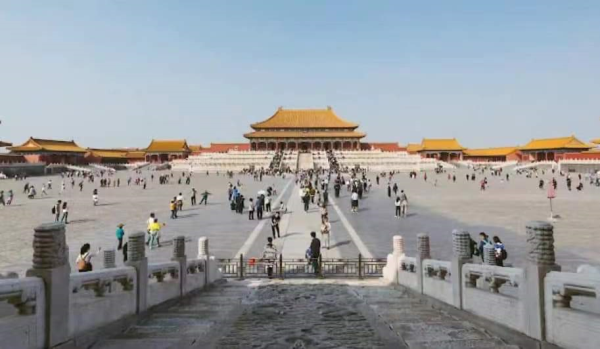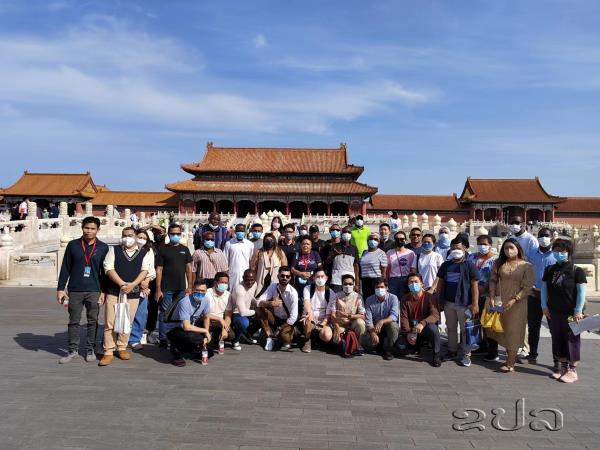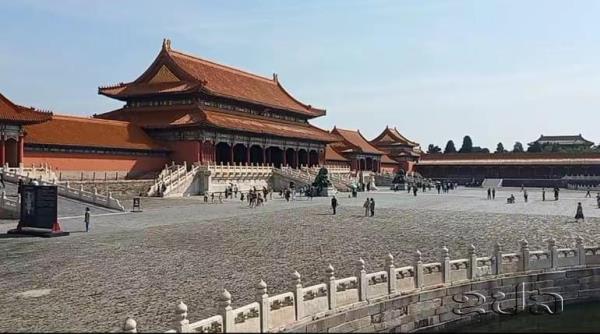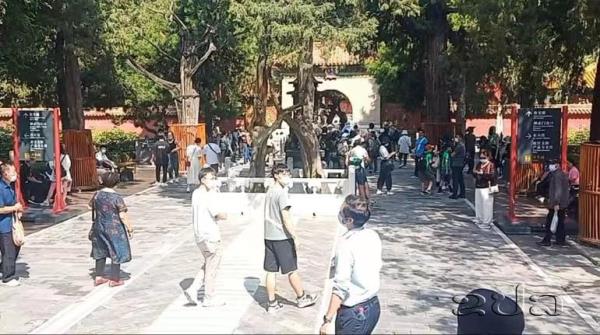KPL
(KPL) Soon after our team of foreign journalists representing several parts of the world arrived at an entrance of the well-known Forbidden City of Beijing, China, we heard announcements made through loudspeakers by relevant officials telling us to comply with anti–Covid-19 restrictions.
Not in a very long distance, tour guides told their respective groups of visitors to get ready before walking through the gate to see firsthand the historic magnificence just inside the enclosed imperial compound.

Forbidden City, Beijing, China
By Sengthong Phasavath
(KPL) Soon after our team of foreign journalists representing several parts of the world arrived at an entrance of the well-known Forbidden City of Beijing, China, we heard announcements made through loudspeakers by relevant officials telling us to comply with anti–Covid-19 restrictions.
Not in a very long distance, tour guides told their respective groups of visitors to get ready before walking through the gate to see firsthand the historic magnificence just inside the enclosed imperial compound.
For globetrotters, this kind of atmosphere simply shows that a famous tourist attraction is about to be explored.
The Forbidden City is located in the centre of Beijing. It is a place that both Chinese and foreign visitors wish to visit. In 1987, UNESCO announced this place a world heritage site as a palatial complex of emperors of the Ming and the Qing dynasties.

Foreign journalists visiting forbidden city, Beijing, China/ Sep 9, 2022
This world’s largest wooden palatial complex was built between 1406 and 1420. It took 14 years and used more than 1 million workers including over 100,000 craftsmen to build this imperial complex which currently ranks top three tourist attractions in China along with Great Wall and Terracotta Army in Xi-an, central China. Its size is more than three times of Louvre Palace in Paris, France. The distance between the north and southern walls is 961 metres while the distance between the gates in the east and west walls is 750 metres.
It is located to the east of Tiananmen Square with Tiananmen Gate standing in between, surrounded by Imperial City and is more than 600 years old, according to chinahighlights.
Between 1420-1912 (492 years) this imperial palace complex was a home to 24 emperors including 14 of the Ming Dynasty and 10 of the Qing Dynasty.
It has many names but it is most commonly known as "The Forbidden City", which is a translation of the Chinese name Zijin Cheng, which literally means "Purple Forbidden City". In the past, the palace was "forbidden" in the sense that, aside from members of the imperial household, no one could enter it without the Emperor's permission.

Forbidden City, Beijing, China
Today, the site is most commonly known to Chinese people as Gugong in Chinese, which means "Former Palace".
Each structure inside the Forbidden City was neatly designed and decorated. Birds cannot land on the palace roofs, which have a special design so as to retain the cleanliness and magnificence of the Forbidden City. To keep the birds from landing on the roofs, the smart craftsmen came up with an idea. They made the slope of each roof higher and made the roof spine wider than the width between a bird’s claws so that birds are unable to land on the roofs.
In this complex, there are 9,999 and half rooms. According to the legend, half a room is missing to avoid upsetting the God of Heaven (who was believed to have 10,000 rooms in his heavenly palace. There is no trees in the outer court unlike the inner one. There are two possible theories - firstly, as the Outer Court was where solemn public ceremonies were held, and the emperors’ “supreme godly power” and imperial dignity were displayed, no trees were allowed, as they would overshadow the majesty of the atmosphere. Secondly, a lack of vegetation would give assassins nowhere to hide, and clear lines of sight for defensive purposes.
The Forbidden City area is rectangular in shape with a total area of 720,000 sq m. Each corner of the city wall has a tower. These towers afford views over both the palace and the city outside.
The Forbidden City is surrounded by a six-metre deep moat and a ten-metre high wall specifically designed to withstand attacks by cannons. The Forbidden City includes five halls, seventeen palaces, and numerous other buildings.
Buildings in the Forbidden City are arranged along three north-south axes. The central axis houses the most important buildings. It runs from Meridian Gate in the south, to the Gate of Divine Might in the north. The "Three Front Halls", the centre of ceremonies, and the "Three Back Palaces", the centre of day-to-day affairs of state, are arranged along the central axis.
Along the eastern axis are a number of semi-independent courtyards. The northern part of the eastern axis served as the Qianlong Emperor's residence in his retirement.
Along the western axis are several gardens and a number of religious buildings. Large parts of the western section are not open to the public. Some buildings are in bad repair; a few were destroyed by fire in 1923 and never rebuilt. In his memoir, Puyi, the last emperor of China, thought that the fire was started by eunuchs wanting to conceal evidence of smuggling treasures out of the palace.
At the northern end of the Forbidden City is the imperial garden. It is home to many trees aging 100 to 300 years old and many rare plants. In this park, there are several shops selling souvenirs, desserts, and beverage.

Imperial garden, Forbidden City, Beijing, China
Royal gardens
The Forbidden City is surrounded by royal gardens. To the west lies Zhongnanhai, the complex of buildings centred on two lakes which serves as the central headquarters for the Communist Party of China. To the north-west lies Beihai Park, which also centres on a lake and is a popular park. To the north lies Jingshan Park, also known as Jing Shan or Coal Hill, where the last Ming emperor hanged himself as the rebel army overran his palace.
Today, Tiananmen Gate in front of the Forbidden City is decorated with a portrait of Mao Zedong in the centre and two placards to the left and right. The left placard reads "Long Live the People's Republic of China"), while the right placard reads "Long Live the Great Unity of the World's Peoples"). The phrase "long live" has great symbolic meaning, as it was traditionally reserved for the Emperors of China, but is now available to the common people and this is also true of the Forbidden City palace itself.
“It's so huge that you need maybe 3-4 days, a whole day visit every each day, to see all parts of its side. This Forbidden City is in recognition of the building's importance as the seat of Chinese power for five centuries, as well as for its unrivalled architecture. Yesterday, we only had time to walk on the main axis of the building complex, the middle part from north to south. But this part which the guide said was the most important, shows how the buildings and ceremonial halls are arranged to convey the impression of great imperial power, including yesterday we got to see the emperor's office, which she said, he used to start working hours at 4 am, hold meetings, etc,” said Fetry Wuriyasti, an Indonesian tourist.
“Forbidden City is an amazing creation. Anyone who sees it will feel that there is a universal knowledge in its architecture. Same for me. Its designs with European and Arabic models are a perfect proof of that. It is said that a viewer can still see only 60% of the entire design. It means that there is much more in that design that we do not see,” said Kelum Shivantha, a visitor from Sri Lanka.
KPL